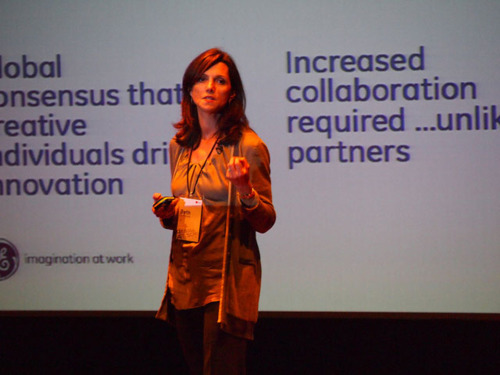
Beth Comstock also co-chaired the Design at Scale event, and she gave a 15 minute snapshot presentation on the importance of design to her in her role as CMO of General Electric. Talk about an eloquent advocate for design. Beth is someone who understands the power of design at a fundamental level, while remaining un-starry-eyed about the challenges of implementing it effectively. That involves deep collaboration from all parties within an organization. Or, as she put it, “what business needs now is design. What design needs now is to be more about business."
Here are seven ways she argued that design can make a difference. (I have a nasty feeling there might have been eight but I missed the last one.)
1. Design Simplifies
The last decade alone has seen an explosion in the amount of data we’re forced to try and parse on a daily basis. And, of course, things are only getting more complex. A jet engine, for instance (GE’s core business) gives off a terabyte of data. Why not harness that information to provide useful insights and do something constructive for the engine or the aviation business at large? Data visualization may be the latest, hottest thing, but when done right, by designers who really understand the meaning and implications of the data they’re visualizing, it can be incredibly powerful. "The IT dept can’t do that,” said Comstock. “That’s where you need great design.”
2. Design Solves and Surprises
Then she told a story of the design team going into a hospital operating theater to study the anesthesiologist at work, the theory being that you could hardly stop them in the course of their work and ask them to explain why they do what they do. After all, “they’re busy saving lives.” Fair point. However, the design team decided to bring in perspective from another group of people accustomed to life/death situations and being surrounded by a ton of bleeping technology: airplane pilots. Then they were able to apply the gems of insights afforded by a clear-eyed perspective to redesign the OR experience.
3. Design Creates Experiences That Matter
“It’s not enough to have the best technology,” said Comstock. “It’s how you deliver it.” She referenced the fairly well-known story of GE’s redesign of an MRI machine for children (see a video, Fun Hospital and MRI Scans for Kids.) As Bob Schwartz of GE Healthcare detailed at the recent Mayo Clinic Transform clinic, this machine didn’t just ensure a less scary experience for the children undergoing treatment, it also reduced the amount of anesthesia that had to be administered, which is a net win all round.
4. Design Integrates
At an engineering-focused company like GE, the tech teams and engineers rule. “They push the limits of science every day,” she said. What they need, however, is the ability to pull all the various pieces and insights together and this, she averred, is a role for design.
5. Design Fails
Quoting the importance of learning from failure, Comstock referenced GE’s “Hardiman,” a human exoskeleton intended to help man lift 1500 pounds. The only problem? The thing itself weighed 1500 pounds. Nonetheless, she talked of the importance of prototyping concepts and allowing ideas to sprout from unexpected places. And she quoted Steelcase’s design chief, James Ludwig: “design’s role is to create space for naivete."
6. Design Has to be Both Local and Global
GE gets a lot of credit for the concept of ”reverse innovation,“ where products are developed in an emerging market and then taken back to the developed world. As it turns out, Comstock "hates the phrase. It’s innovation as it should be” even as she acknowledges that this is an important new frontier in innovation, and an area where design can make a singular impact.
7. Design Creates a Vision for the Future
“If you can’t tell a story, you can’t sell a story,” she said, talking up the ability for design to map out a vision of what’s possible. She referenced an idea someone at GE had had for an air taxi which resulted in a joint venture with Honda to create a Very Light Jet. Turns out, someone at Honda had been thinking about trying to make cars fly, and together the design teams are working on both developing a new reality and dreaming up a potential future.
[Image c/o DMI.]
evergueiro-blog reblogged this from thoughtyoushouldseethis-blog
evergueiro-blog liked this
wellmankil-blog liked this
swamui9-blog liked this
 jeanphony-blog reblogged this from thoughtyoushouldseethis-blog
jeanphony-blog reblogged this from thoughtyoushouldseethis-blog clemauyeung-blog reblogged this from thoughtyoushouldseethis-blog
studiotondo-blog reblogged this from thoughtyoushouldseethis-blog
broodr-blog reblogged this from thoughtyoushouldseethis-blog
vintageredesigned-blog reblogged this from thoughtyoushouldseethis-blog
vintageredesigned-blog liked this
oscarthinks liked this
clemauyeung-blog liked this
thoughtyoushouldseethis-blog posted this
- Show more notes